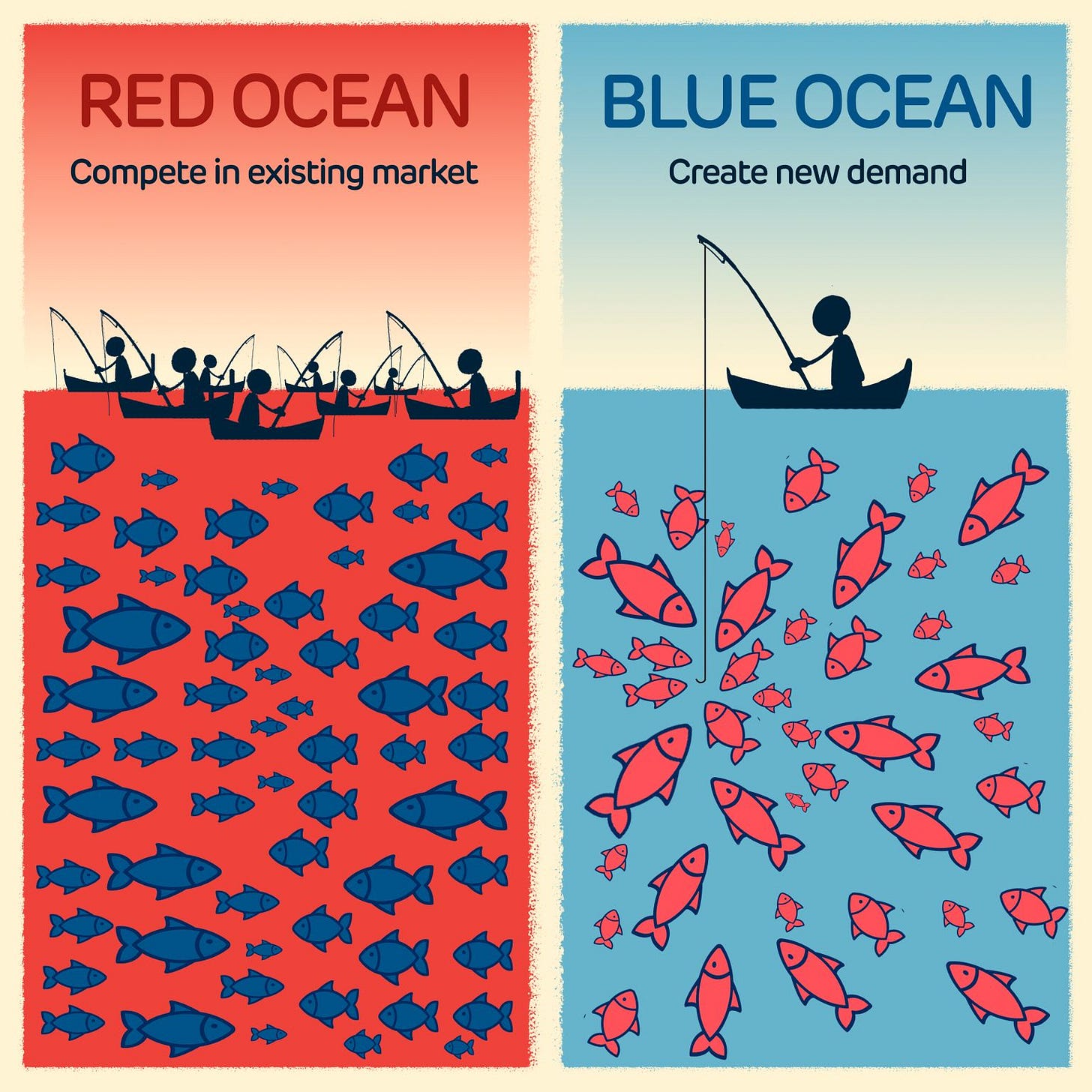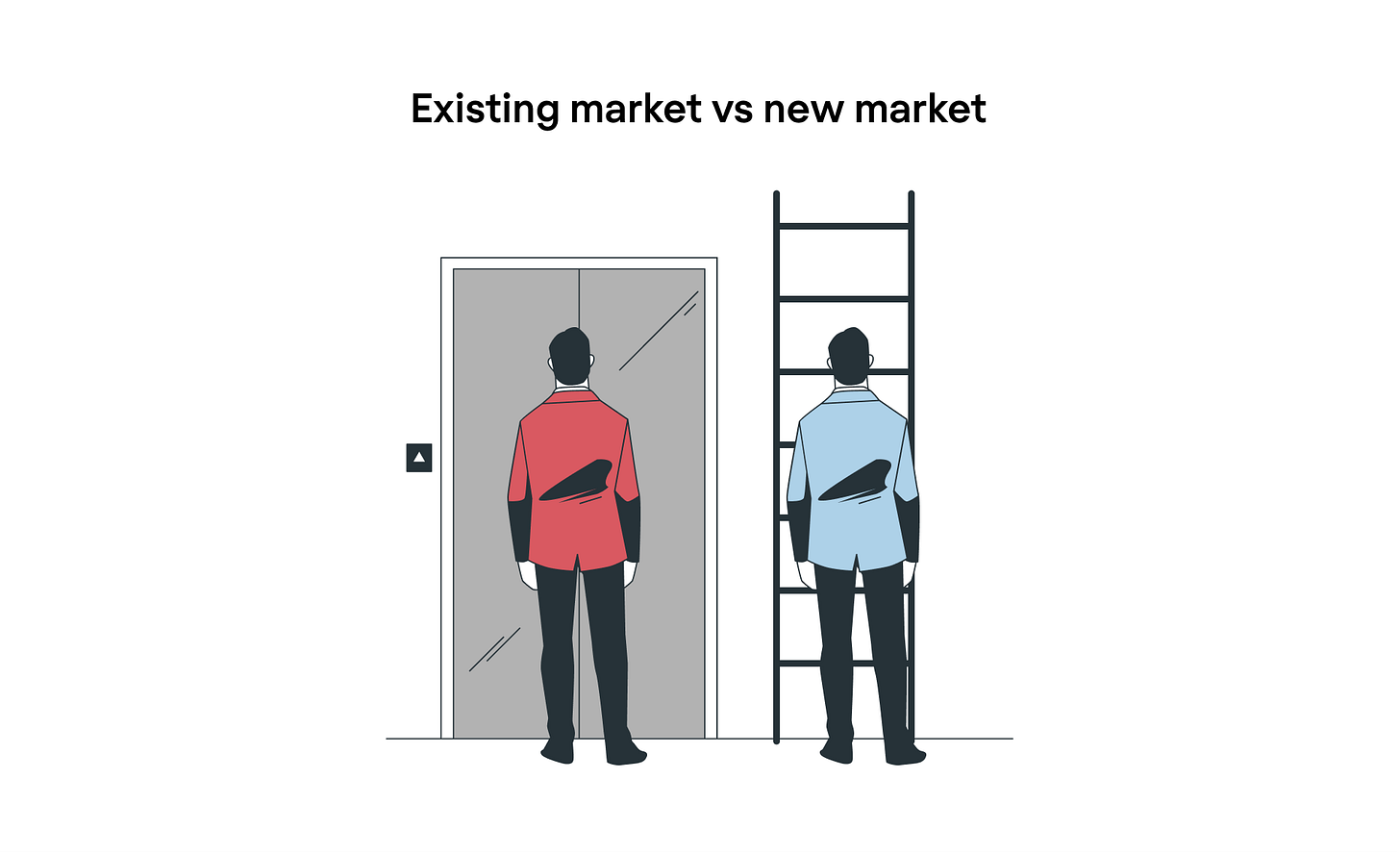Red Ocean vs. Blue Ocean
ANOTHER DAY—ANOTHER STARTUP INSIGHT
Hey founders,
Welcome to another week of startup insight!
If you’re new here, I’m Gracie Van, the writer behind this newsletter, on the mission to build a startup community (What A Startup) for young and early-stage startup founders. I’m here to help founders grow through startup resources and networks, and get inspired by startup success stories.
It only takes 5 minutes to read my newsletter.
If you can't stay and read for just 5 minutes without clicking away, I've got some news for you: YOU ARE NOT GONNA MAKE IT!
Most startups face one question early on:
“How do I stand out?”
If you’ve ever asked yourself this, the answer might lie in understanding the difference between a Red Ocean and a Blue Ocean strategy.
Choosing the right market strategy can be the difference between simply surviving and truly thriving.
These concepts describe 2 very different approaches to market competition, and understanding them can help you shape the direction and strategy of your business.
Here’s what you need to know:
Red Ocean: competing in crowded waters
A Red Ocean represents markets with heavy competition. Companies fight for a share of the same market, often leading to price wars and limited room for new entrants to stand out.
Signs of a Red Ocean:
Lots of competition, all offering similar products or services.
Price wars: competitors constantly undercut each other.
Limited innovation—most businesses follow the same playbook.
Customers are loyal to the brand that offers the best price, not necessarily value.
Pros of a Red Ocean:
Proven market: There’s already demand for the product or service.
Predictable metrics: Established competitors offer benchmarks to understand customer needs, market size, and pricing.
Cons of a Red Ocean:
High competition: Entering a crowded space can be difficult without a strong differentiator.
Pressure on profit margins: Increased competition can lead to price-cutting, which squeezes profit margins.
Example: If you launch a fast food chain, you’ll face competition from giants like McDonald’s, Burger King, and Wendy’s. Success in this Red Ocean requires outperforming competitors on factors like price, convenience, or speed, often by following existing market standards.
Blue Ocean: creating new opportunities
A Blue Ocean strategy means carving out new, untapped markets with minimal or no competition. Rather than competing for a piece of the same pie, you create new demand and position yourself as a pioneer
Signs of a Blue Ocean:
Few or no competitors, allowing you to define the market.
Focus is on creating value, not just competing on price.
Innovation and differentiation are the main focus.
You’re solving a problem or meeting a need that hasn’t been addressed.
Pros of a Blue Ocean:
Less competition: Being a trailblazer gives you an advantage, as others are not vying for the same customers.
Higher profit potential: Creating new demand allows you to capture customer attention without the pressure to lower prices.
Cons of a Blue Ocean:
Uncertain market: The new market might take time to mature, with unknown challenges.
Need for education: Pioneering something new requires educating your audience, which can be a significant investment of time and money.
Example: Apple created a Blue Ocean with the iPhone, redefining what a smartphone could be, while Tesla opened up a Blue Ocean with electric vehicles, setting new standards in the automotive industry. Both companies created massive new markets by addressing needs that had gone unmet by traditional solutions.
Why does it matter for your business?
Knowing whether you're in a Red or Blue Ocean affects your strategy and decision-making in key ways:
Market dynamics: Understand whether you're up against heavy competition or pioneering a new market. Tailor your approach accordingly.
Pricing strategy: In Red Oceans, price wars are common. In Blue Oceans, you can set premium prices based on innovation and value.
Value proposition: Red Oceans need a focus on differentiation; Blue Oceans focus on unique solutions and unmet needs.
Marketing & sales tactics: Compete for attention in Red Oceans; educate and create demand in Blue Oceans.
Resource allocation: Red Oceans require competitive edge investment, while Blue Oceans focus on innovation and education.
Growth potential: Red Oceans may limit scalability, while Blue Oceans offer higher growth potential with fewer direct competitors.
Risk management: Red Oceans carry risks of price wars and saturation, while Blue Oceans face market uncertainty.
Partnership strategy: Blue Oceans attract innovative partners; Red Oceans may form alliances to gain competitive edges.
In short, knowing your ocean clarifies your strategy, helps you make better decisions, and aligns your business goals with your market environment.
Reality check: success isn’t guaranteed in either ocean
Blue Ocean: A fresh market space sounds ideal, but it comes with challenges. You’ll need to:
Educate the market: Introducing something new means creating demand and building awareness.
Overcome resistance: Expect initial skepticism or resistance to a new concept.
Red Ocean: It may be competitive, but don’t count it out! If you can:
Offer a strong value proposition: Stand out with unique features or benefits that competitors lack.
Leverage established demand: Tap into a market where customers are already interested.
Key Takeaway: Success relies more on your strategy and execution than just your market choice. Whether Red or Blue, clarity, adaptability, and a solid game plan make all the difference.
Making the transition: from Red to Blue
If you find that you’re in a Red Ocean, don’t despair!
Sometimes, even within a Red Ocean, you can find new opportunities by identifying gaps and unmet needs.
Example: Dollar Shave Club disrupted the saturated razor market (a Red Ocean) by launching a subscription model that simplified and personalized the buying experience.
👉 Here are 50 ways to turn the Red Ocean into the Blue Ocean
Actions you can take right now
Conduct a competitive audit:
List your direct and indirect competitors and identify their strengths and weaknesses.
Where can you improve on their offering or create something totally different?
Talk to your customers:
Gather feedback to better understand their pain points and unmet needs.
Is there something your competitors are missing that you could provide?
Brainstorm innovations:
Look at your product and ask yourself how you can improve it in ways that competitors haven’t considered.
Could you add more value, make it easier to use, or offer a new feature?
Test a pivot:
Run a small test or pilot to introduce a new approach—whether it's a new pricing model, added feature, or simplified process—to see how customers respond.
Sara Blakely always says:
“Entrepreneurs do one of two things: either they create something brand new, or they make something that exists better.”
If you’re in the Blue Ocean, great, you’re creating something new.
If you’re in the Red Ocean, you should make something that exists better.
That’s how you’re going to be successful.
THANKS FOR READING!
- Gracie from What A Startup







